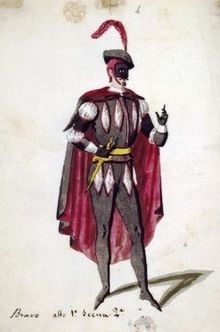Il bravo
| Work data | |
|---|---|
| Title: | Il bravo |
| Original title: | Il bravo, ossia La veneziana |

Title page of the libretto, Milan 1839 |
|
| Shape: | Opera in three acts |
| Original language: | Italian |
| Music: | Saverio Mercadante |
| Libretto : | Gaetano Rossi |
| Literary source: | Acting La Vénitienne by Auguste Ancient-Bourgeois |
| Premiere: | March 9, 1839 |
| Place of premiere: | Teatro alla Scala , Milan |
| Playing time: | approx. 3 ¼ hours |
| Place and time of the action: | Venice, 16th century |
| people | |
|
|
Il bravo, ossia La veneziana (literally: "The hired murderer or The Venetian") is an opera in three acts by Saverio Mercadante . Gaetano Rossi wrote the text based on the play Le Vénitienne by Auguste Ancient-Bourgeois. The premiere took place on March 9, 1839 at the Teatro alla Scala in Milan .
action
Prehistory: Because Carlo once murdered his wife, he has to wear a black mask as a punishment as "the Bravo" to serve the council of Venice as a contract killer . His father was taken prisoner as a pledge for his loyalty.
first act
Foscari has fallen in love with a girl who is kept hidden in Maffeo's house. Since Maffeo had denied him entry, Foscari instructs his henchmen to kill Maffeo. Meanwhile, the Bravo receives a visit from Pisani. Although he was banished from Venice, he has returned to look for his lover. He persuades Bravo to lend him his mask for two days. Maffeo's body is found. Violetta, the girl from Maffeo's house, joins them. Both the Bravo, now dressed as a nobleman, and Foscari offer her protection. Pisani, in the mask of Bravo, recognizes the girl as his lover. Violetta accepts the help of Bravo, who protects her from Foscari's intrusiveness.
Second act
Teodora learns of Maffeo's death and that her daughter Violetta is in the care of a stranger. She asks the Bravo (in this case the masked Pisani) for help. The real Bravo tells Violetta that Teodora is her mother and leads the girl to her. When a fire breaks out in Teodora's Palazzo, they all flee.
Third act
Teodora and her daughter Violetta get closer. The Bravo recognizes in Teodora his wife, who was supposedly killed by him. Pisani asks for Violetta's hand. Bravo urges the young couple to flee. Before he and Pisani swap masks again, Pisani gives the real Bravo a new assignment that he had received. This says that the Bravo should kill Teodora, which he does not have the heart. Finally Teodora snatches his dagger from him and kills himself. Shortly afterwards, the Bravo receives the message that his criminal service is over because his father died in dungeon.
Instrumentation
The orchestral line-up for the opera includes the following instruments:
- Woodwinds : flute piccolo , two flutes , two oboes , two clarinets , two bassoons
- Brass : four horns , two trumpets , three trombones , serpent
- Timpani , percussion : bass drum , bell in 2nd
- two harps
- Strings
- Incidental music: Banda (unspecified)
Work history
The first performance of Il bravo on March 9, 1839 at the Teatro alla Scala in Milan was one of Mercadante's greatest successes. Eugenio Cavallini was the first violinist to conduct the music. Directed by Bartolomeo Merelli . The set was designed by Baldassarre Cavallotti and Domenico Menozzi. The cast included the two singing stars Domenico Donzelli in the title role and Eugenia Tadolini as Violetta as well as Pietro Balzar (Foscari), Antonio Benciolini (Capello), Andrea Castellan (Pisani), Eutimio Polonini (Marco), Luigi Quattrini (Luigi), Sofia Dall ' Oca-Schoberlechner (Teodora) and Angela "Angiolina" Villa (Michelina).
It followed u. a. Performances in Naples and Berlin in 1840 , Vienna , Lisbon and Barcelona in 1841 , Hanover in 1851 , Paris in 1853 and again in Milan in 1893. More recently, performances have taken place in Rome in 1976 and at the Martina Franca Festival in 1990 . The latter performance in particular, which was enthusiastically received by both critics and audiences, initiated a new preoccupation with Mercadante's work.
Total recordings
- 1976 with Shigemi Matsumoto, Maria Parazzini, William Johns, Antonio Savastano, Orchestra del Teatro dell'Opera di Roma, Gabriele Ferro (Cetra)
- 1990 with Janet Perry , Adelisa Tabaidon, Dino di Domenico, Sergio Bertocchi, Orchestra Internazionale d'Italia, Bruno Aprea (Nuovo Era)
swell
- Reclam's opera guide
- Piper's Encyclopedia of Musical Theater
- Steiger: Operas - A directory of all recordings
Web links
- Il bravo : Sheet music and audio files in the International Music Score Library Project
- Libretto (Italian), Milan 1839. Digitized in the Internet Archive
- Work information and libretto (Italian) as full text on librettidopera.it
- Il bravo, ossia La veneziana (Saverio Mercadante) in the Corago information system of the University of Bologna
- Work data for Il bravo, ossia La veneziana based on MGG with discography at Operone
- Discography of Il bravo at Operadis
Individual evidence
- ^ Rein A. Zondergeld : Il bravo. In: Piper's Encyclopedia of Musical Theater . Volume 4: Works. Massine - Piccinni. Piper, Munich / Zurich 1991, ISBN 3-492-02414-9 , pp. 79-83.
- ^ March 9, 1839: "Il bravo". In: L'Almanacco di Gherardo Casaglia ., Accessed on July 28, 2019.
